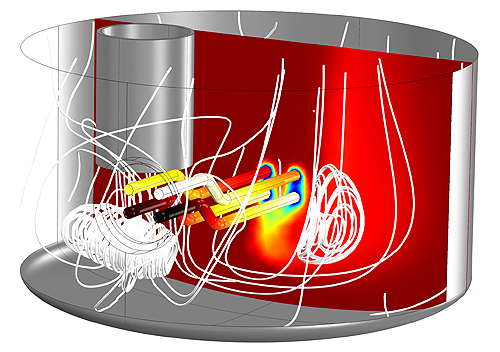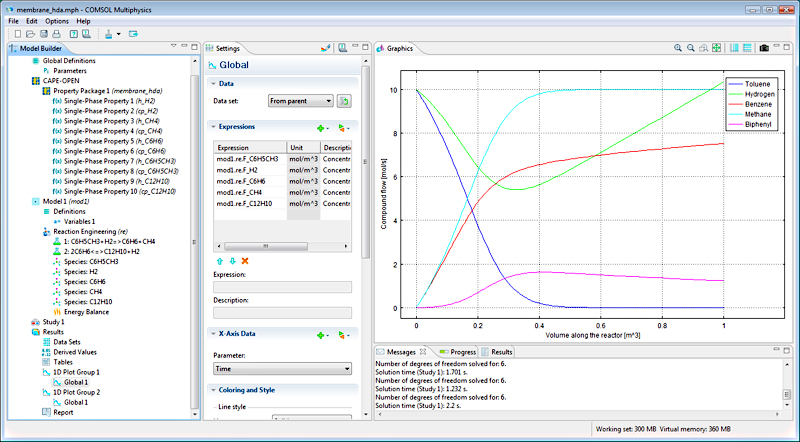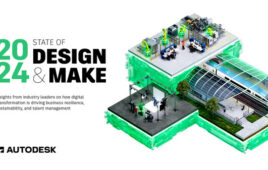BURLINGTON, MA — COMSOL Inc releases the Chemical Reaction Engineering Module. This new module is built on the COMSOL platform to create a single environment where engineers and scientists obtain highly accurate studies of material transport and chemical reactions of a wide assortment of chemistries under different operating conditions. Users can simulate reaction systems ranging from micro-reactors in biotechnology to unit operations in chemical processes and gain essential knowledge early in the development phase. The net result is more cost-effective and efficient development cycles for both products and processes.
“The Chemical Reaction Engineering Module is suitable for a diverse range of product and process development applications,” says Henrik von Schenk, Chemical Engineering Product Manager with COMSOL. “It’s particularly useful in the design of sensors for analytical instruments as well as for designing catalysts and filters in automotive exhaust systems. The Chemical Reaction Engineering Module will be especially valuable when developing products and processes in industries like consumer products, fine and specialty chemicals, pharmaceuticals, and bulk chemicals.

This image was created using the Chemical Reaction Engineering Module and shows the removal of CaCO3 (lime) from heating elements in a boiler.
The Chemical Reaction Engineering Module, which combines functionality of two earlier modules, the Chemical Engineering Module and the Reaction Engineering Module, leverages the newly re-engineered COMSOL version 4 architecture to deliver major new functionality and superior usability. With the new module, engineers and scientists can investigate chemical reactions under the controlled conditions of perfectly mixed systems in laboratory studies. Since reactions are directly accessible in a single easy-to-use interface, users can study the influence of multiple concentration and temperature variations in real operating conditions.
“The fusion of our premier chemical engineering capabilities into a single dedicated solution offering an all-inclusive, easy-to-use environment is a great convenience for our customers,” says von Schenk. “Productivity jumps with the new workflow and the ease with which users can manage species, reactions, and material and energy transport in one simulation.
The Chemical Reaction Engineering Module’s easy-to-use customizable interfaces for defining chemical reactions, mass and energy transport, and porous media flow help users simulate reacting systems accurately. Fully integrated in the COMSOL Multiphysics model set up, the chemical reaction interface enables users to simply type in their chemical reaction formulas. The software then automatically computes the reaction kinetics as well as defines the mass and energy balances. When done, the resulting mass and energy balances are ready to be used to solve the reactor models for perfectly mixed systems of batch reactors, semi-batch reactors, CSTR, and plug-flow reactors.
Users can easily move up from these smaller, less computationally demanding simulations of perfectly mixed reactor models to larger-scale simulations of time- and space-dependent models. “The Chemical Reaction Engineering Module helps you make smart design decisions quickly using comparisons between ideal reactor models and detailed time and space simulations,” explains von Schenk. “It lets you handle simulations beginning at a simple level, which makes it easy to evaluate the chemistry of a system and find reaction time scales, temperatures, and ideal operating conditions. Then, you can use the identical model to run full 3D simulations for investigating and designing processes and reactors in real-world operating conditions.
The Chemical Reaction Engineering Module provides interfaces for mass transport that describe species transport by diffusion, convection, and migration in dilute and concentrated solutions. These interfaces can also describe transport in free and porous media. Based on principal physics effects that come as standard interfaces in COMSOL, laminar flow and heat transfer can be included in the simulation as well. Still, no matter what physics effect is involved, model set up is quick and follows the same intuitive operations. Users can also add and remove chemical reactions and species as well as change reaction mechanisms on the fly. Users can maintain several studies each with different chemistries and different operating conditions in the same model
Import Thermodynamic Property Data Into COMSOL
The Chemical Reaction Engineering Module is compliant with CAPE-OPEN standards for modeling, simulating, and designing the operations of chemical processes. Additionally, it has the ability to read CHEMKIN® files, which define complete reacting systems, including physical and thermodynamic properties, for combustion, atmospheric chemistry, and other gas-phase reacting systems.
With the Chemical Reaction Engineering Module’s built-in CAPE-OPEN Wizard, users can combine components from multiple third-party software vendors in their COMSOL simulations. An integrated CAPE-OPEN browser makes finding and selecting thermodynamic and physical property information in external property data packages easy. This flexible combination of openness and ease of use can lead to high-fidelity descriptions of such properties as viscosity, density, heat capacity, and other thermodynamic properties for gases and liquids.

The Chemical Reaction Engineering Module brings ease of use for the simulation of reacting system. With its built-in CAPE-OPEN support, users can combine thermodynamic property data from multiple third-party software vendors in their COMSOL simulations. The figure shows the results of the simulation of a hydroalkylation process carried out in a membrane reactor.
Chemical Reaction Engineering Module Highlights
• Automatic generation of reaction kinetics, mass, and energy balances from chemical reaction formulas
• Allows combinations of perfectly mixed reactor models to detailed time- and space-dependent descriptions in one model
• Extensive interfaces for simulating mass transport by diffusion, convection, and migration in dilute and concentrated solutions as well as in free and porous media
• Functionality for investigating different chemistries and operating conditions by adding and removing reactions, chemical species, and mass transport effects in different studies in a single model
• Predefined chemical reactor types such as batch and semi-batch reactors, CSTR, and plug flow reactors for continuous volume and variable volume simulations
• User-defined functions and expressions that extend usability for defining arbitrary reaction kinetics and for describing physical properties as a function of composition and temperature
• CAPE-OPEN interface for rapid thermodynamics and physical property calculations through connecting to third-party chemical engineering simulation software
• CHEMKIN file import for combustion, atmospheric chemistry, and other gas-phase reacting systems
The Chemical Reaction Engineering Module is available for the Windows, Linux, and the Macintosh operating systems directly from COMSOL and from COMSOL’s global network of distributors on June 28, 2010.
Users of the Chemical Engineering Module with a current software license subscription will receive a one-time upgrade to the Chemical Reaction Engineering Module plus the COMSOL CFD Module at no additional cost. Full details about the new Chemical Reaction Engineering Module, COMSOL Multiphysics version 4.0a, and related products are available at www.comsol.com.
COMSOL
www.comsol.com
::Design World::
Filed Under: Software • FEA, Software • simulation, ENGINEERING SOFTWARE





Tell Us What You Think!